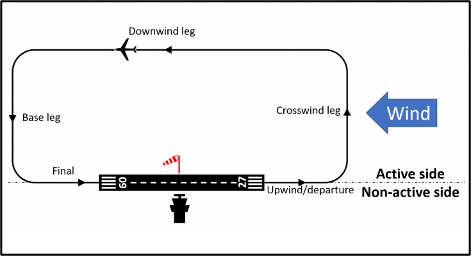Circuits
A standard traffic circuit consists of four legs: crosswind, downwind, base, and final.
In general, a standard traffic circuit is a left-hand circuit at 1000ft AGL. (This is general common practice, and is in fact a rule in Iceland.)
Certain aerodromes, however, may have published circuits which are non-standard in some way. For example, BIKF has a standard circuit altitude of 1200ft, and uses right hand circuits for RWYs 10 & 19. Consult with LOPs and the AIP to confirm if an airport has a published non-standard traffic circuit.
VFR departure clearances for circuits shall include the direction of the circuit (left/right.) While not strictly required, it is recommended to also state the altitude of the circuit, as VATSIM pilots are often unfamiliar with standard circuit altitudes. The following phraseology shall be used:
[CALLSIGN], after departure [LEFT/RIGHT] hand circuits, [ALT]*, [WINDS], [RWY], cleared for takeoff.
(*may be omitted)
For example:
🎧 (TF-)SKN, after departure right-hand circuits, 1000ft, winds 020 degrees 6 knots, runway 01, cleared for takeoff.
When an aircraft is in the circuit, TWR should inform them of their order in the sequence, and confirm their intentions if not previously known (touch & go, full-stop landing, etc.)
While it is not required for aircraft to report any particular leg of the circuit if not prompted, one may ask an aircraft to report upwind, downwind, crosswind, base, or final if one considers it necessary to maintain situational awareness and manage the traffic in the CTR.
At any point once there is no further traffic ahead in the sequence, TWR may clear an aircraft in the circuit to land (or perform a touch & go, low approach, etc.
- If the aircraft is doing a full-stop landing, they will land and vacate the runway, after which TWR/GND may taxi them to the appropriate apron (e.g., Fluggardar).
- If an aircraft is doing a low approach, touch & go, or stop & go (stopping on the runway, then taking off again), then once they are climbing, TWR should give them their new order in the sequence (if it has changed), ask for their intentions again, and then repeat all of the above.
Occasionally, a VFR arrival may have to go around. If there is conflicting traffic, the aircraft should be instructed to turn left/right immediately for an early crosswind, to avoid a collision. Otherwise, they may simply rejoin the circuit as usual.

